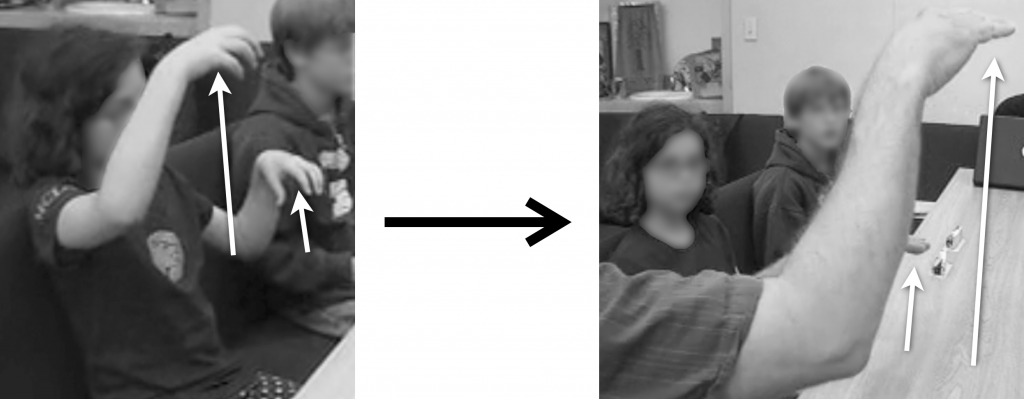Multimodal revoicing was first described by Shein (2012) as a way teachers repeat students’ gestures to restate ideas. In our work, we identify different forms of multimodal revoicing.

A tutor multimodally revoices a student’s idea about speed by subtly reformulating what she says and refining her gesture to highlight certain aspects of what was depicted.
Multimodal revoicing can take many forms:
Through multimodal revoicing, teachers can help students connect their initial, embodied understandings of phenomena expressed in gesture (e.g., the feeling of “going faster”) with more refined, disciplinary ways of describing those phenomena (e.g., a mathematical definition of faster as greater distance traveled in the same amount of time).
When students share ideas with gesture, teachers can repeat and reformulate those gestures, refining both the imagery and the language used.
Multimodal revoicing in whole-class discussion:
- Repeat and broadcast students’ gestures to class: Teachers repeat students gestures to help make visuo-spatial embodied knowledge students share available to the whole onlooking class
- Enhance students’ verbal contributions with gesture: Teachers repeat what students say, and add gestures to provide a visual or embodied illustration of the concept for the onlooking class that was originally shared by the student only in words
- Expand students’ contributions by elaborating their gestures: Teachers repeat what students say and repeat their gestures, but expand on the gestures by elaborating with additional parts or details in gesture for the onlooking class
Flood, V. J. (2018). Multimodal revoicing as an interactional mechanism for connecting scientific and everyday concepts. Human Development, 61(3), 145-173. https://doi.org/10.1159/000488693
Flood, V. J. (2021). The secret multimodal life of IREs: Looking more closely at representational gestures in a familiar questioning sequence. Linguistics and Education, 63, 100913. https://doi.org/10.1016/j.linged.2021.100913
Flood, V. J. Wang, X. C., & Sheridan, M. (2022) Embodied responsive teaching for supporting computational thinking in early childhood. In C. Chinn, E. Tan, C. Chan, & Y. Kali (Eds.). Proceedings of the 16th International Conference of the Learning Sciences (ICLS) 2022 (pp. 855-862). Hiroshima, Japan: International Society of the Learning Sciences.
Flood, V. J. & Harrer, B. W. (2022). Teachers’ responsiveness to students’ gestured candidate responses in STEM whole-class interactions. Classroom Discourse. https://doi.org/10.1080/19463014.2022.2080086
